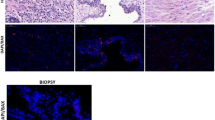Abstract
Introduction:Benign prostatic hyperplasia (BPH) is a slowly progressive abnormal glandular enlargement with heterogeneous morphology. Disruption of apoptotic pathways has been suggested as an important regulatory mechanism in this common and significantly morbid disease.
Methods:Prostatic tissue from 20 patients with BPH and no prior or subsequent prostatic carcinoma was obtained by transurethral prostatectomy (TURP) at the University of California Davis. Apoptotic regulatory proteins: BCL2, BAX and p27 were analyzed by immunohistochemistry and evaluated for expression in four distinct histologic patterns: hyperplastic epithelium, nodules, dilated glands and atrophic/inflammatory glands.
Results:Particularly striking was the decreased expression of BAX and an abnormal BCL2 : BAX ratio within all nodules relative to expression in other epithelial patterns. p27 expression was decreased in 35% of the hyperplastic epithelial areas and 10% of the nodules.
Discussion:Overall, abnormal expression of BCL2, BAX and/or p27 was identified in the hyperplastic epithelium of 19 (90%) of specimens and all 12 (100%) of the hyperplastic nodules. The high frequency of abnormalities in apoptosis regulatory genes, suggests that alteration of apoptotic pathways is important for the development of this condition.


Similar content being viewed by others
References
Kortt MA, Bootman JL . The economics of benign prostatic hyperplasia treatment: a literature review. Clin Ther 1996; 18: 1227–1241.
Grayhack JT, Kozlowski JM, Lee C . The pathogenesis of benign prostatic hyperplasia: a proposed hypothesis and critical evaluation. J Urol 1998; 160: 2375–2380.
McNeal J . Pathology of benign prostatic hyperplasia. Insight into etiology. Urol Clin N Am 1990; 17: 477–486.
Claus S, Berges R, Senge T, Schulze H . Cell kinetics in epithelium and stroma of benign prostatic hyperplasia. J Urol 1997; 158: 217–221.
Colombel M et al. Zonal variation of apoptosis and proliferation in the normal prostate and in benign prostatic hyperplasia. Br J Urol 1998; 82: 380–385.
Kyprianou N, Huacheng T, Jacobs SC . Apoptotic vs proliferative activities in human benign prostatic hyperplasia. Hum Pathol 1996; 27: 668–675.
Limas C, Frizelle SP . Proliferative activity in benign and neoplastic prostatic epithelium. J Pathol 1994; 74: 201–208.
Cardillo M et al. Resistance to apoptosis and up regulation of BCL2 in benign prostatic hyperplasia after androgen deprivation. J Urol 1997; 158: 212–216.
Rakozy C et al. Expression of BCL2, p53 and p21 in benign and malignant prostatic tissue before and after radiation therapy. Mod Pathol 1998; 11: 892–899.
Gandour-Edwards R, Huang A, Dietch A, deVere-White R . Immunolocalization of BCL2 in benign prostatic epithelium. An evaluation of the effects of androgen ablation. J Urol Pathol 1998; 7: 157–165.
Basu A, Haldar S . The relationship between BCL2, BAX and p53: consequences for cell cycle progression and cell death. Mol Hum Reprod 1998; 4: 1089–1109.
Vang E, Korsmeyer SJ . Molecular thanatopsis: a discourse on the BCL2 family and cell death. Blood 1996; 88: 386–401.
Oltvai ZN, Milliman CL, Korsmeyer SJ . Bcl-2 heterodimerizes in vivo with a conserved homolog, Bax that accelerates programmed cell death. Cell 1993; 74: 609–619.
Perlman H et al. An elevated bax/bcl-2 ratio corresponds with the onset of prostate epithelial cell apoptosis. Cell Death Diff 1999; 6: 48–54.
Bruckheimer EM et al. The impact of bcl-2 expression and bax deficiency on prostate homeostasis in vivo. Oncogene 2000; 19: 2404–2412.
Nakayama K et al. Mice lacking p27(Kip1) display increased body size, multiple organ hyperplasia, retinal dysplasia, and pituitary tumors. Cell 1996; 85: 707–720.
Guo Y, Sklar GN, Borkowski A, Kyprianou N . Loss of the cyclin–dependent kinase inhibitor p27 (Kip1) protein in human prostate cancer correlates with tumor grade. Clin Cancer Res 1997; 12 (Part 1): 2269–2274.
Cordon-Cardo C et al. Distinct altered patterns of p27 gene expression in benign prostatic hyperplasia and prostatic carcinoma. J Natl Cancer Inst 1998; 90: 1284–1291.
Brooks JD et al. CG island methylation changes near the GSTP1 gene in prostatic intraepithelial neoplasia. Cancer Epidemiol Biomarkers Prev 1998; 7: 531–536.
Pardo FS, Su M, Borek C . Cyclin D1 induced apoptosis maintains the integrity of the G1/S checkpoint following ionizing radiation irradiation. Somat Cell Mol Genet 1996; 22: 135–144.
Collins K, Jacks T, Pavaletich N . The cell cycle and cancer. Proc Natl Acad Sci, USA 1997; 94: 2776–2778.
Kyprianou N et al. Induction of prostate apoptosis by doxazosin in benign prostatic hyperplasia. J Urol 1998; 159: 1810–1815.
Chon JK et al. α-adrenoreceptor antagonists terazosin and doxazosin induce prostate apoptosis without affecting cell proliferation in patients with benign prostatic hyperplasia. J Urol 1999; 161: 2002–2008.
Kishi H et al. Expression of the survivin gene in prostate cancer: correlation with clinicopathological characteristics, proliferative activity and apoptosis. J Urol 2004; 171: 1855–1860.
Drobnjak M et al. Altered expression of p27 and Skp2 proteins in prostate cancer of African-American patients. Clin Cancer Res 2003; 9: 2613–2619.
Acknowledgements
Our work was supported by a grant from the National Institute for Aging (AG15404).
Author information
Authors and Affiliations
Corresponding author
Rights and permissions
About this article
Cite this article
Gandour-Edwards, R., Mack, P., deVere-White, R. et al. Abnormalities of apoptotic and cell cycle regulatory proteins in distinct histopathologic components of benign prostatic hyperplasia. Prostate Cancer Prostatic Dis 7, 321–326 (2004). https://doi.org/10.1038/sj.pcan.4500749
Received:
Revised:
Accepted:
Published:
Issue Date:
DOI: https://doi.org/10.1038/sj.pcan.4500749
- Springer Nature Limited
Keywords
This article is cited by
-
Expression of p27(Kip1), cyclin D3 and Ki67 in BPH, prostate cancer and hormone-treated prostate cancer cells
International Urology and Nephrology (2008)
-
Increased therapeutic potential of an experimental anti-mitotic inhibitor SB715992 by genistein in PC-3 human prostate cancer cell line
BMC Cancer (2006)




